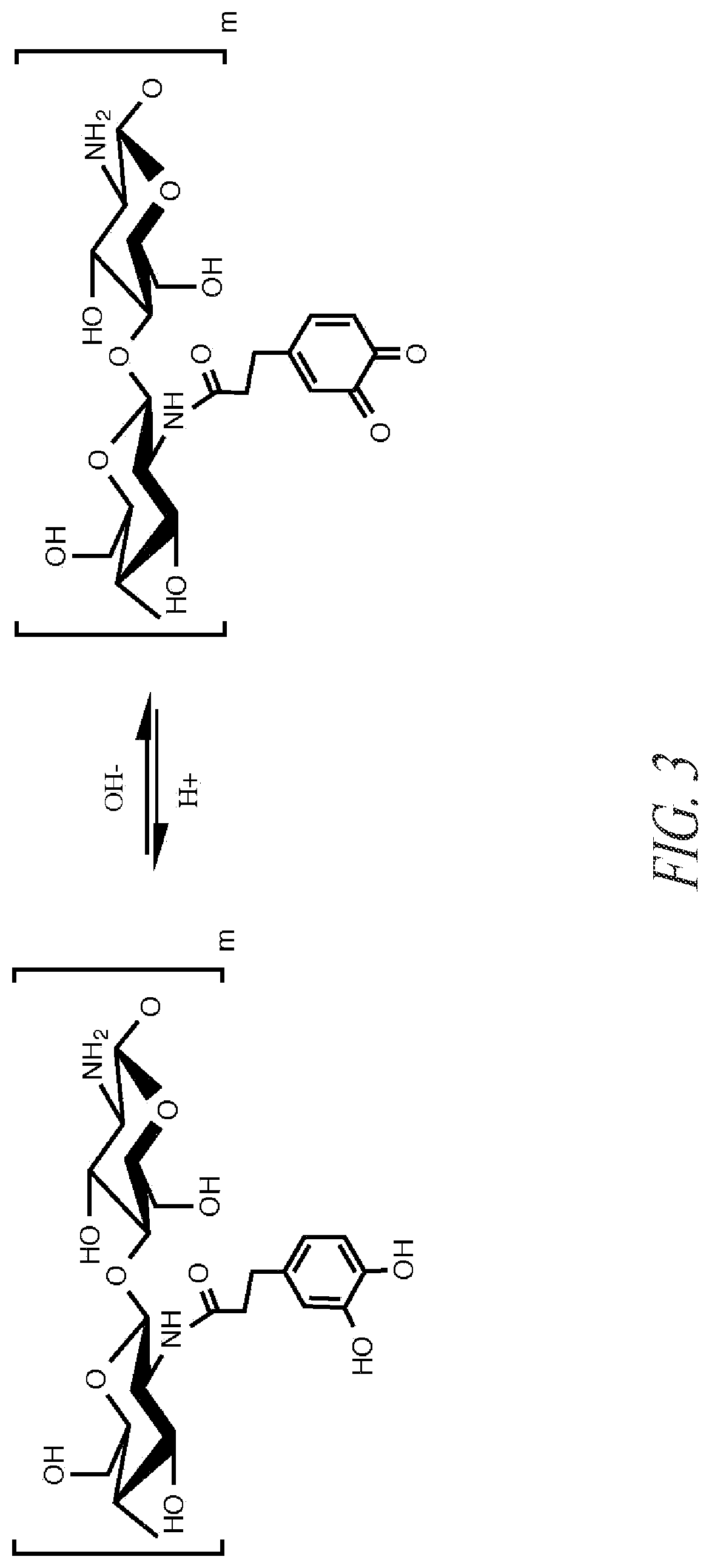Chitosan dressing for control of gastrointestinal bleeding
a technology of gastrointestinal bleeding and chitosan, applied in the field of chitosan materials, can solve the problems of prolonged bleeding, high difficulty in delivery, adhesion, enzyme activity and acidity considerations, and high risk of mortality and morbidity, and achieve the effects of rapid control of brisk arterial bleeding, reduced morbidity and mortality, and reduced associated health care expenditur
- Summary
- Abstract
- Description
- Claims
- Application Information
AI Technical Summary
Benefits of technology
Problems solved by technology
Method used
Image
Examples
example 1
Preparation of Catechol Chitosan and Characterization
Approach 1.
[0128]Chitosan A (9.0 g) was dissolved in deionized water (148 g) and HCl (28 ml, 1.0 M HCl). A 1:1 (150 ml) solution of water:ethanol was prepared. 3,4-dihydroxyhydrocinnamic acid (25.9 mmol) and N-(3-dimethylaminopropyl)-N′-ethylcarbodiimide hydrochloride (51.8 mmol) were dissolved in the water / alcohol solution. The water / alcohol solution was added to the chitosan solution. The solutions were vigorously mixed. The reaction mixture was controlled to pH 5.4 using dropwise addition of 0.1 M HCl and 0.1 NaOH solution and left to react with overhead stirring for at least 12 hours. Following this, the chitosan solution (˜300 ml) was dialyzed against 5 liters of water acidified with 1 drop of 1.0 M HCl solution for six days and against non-acidified water for at least 3 hours. Dialysate was changed at −24 hour intervals throughout the duration of the dialysis with at least 5 changes of water.
Approach 2
[0129]Chitosan A (1.5 g...
example 2
Freeze Phase Separated Hydrophilic Polymer Dressings
[0138]Hydrophilic polymer aqueous solutions were prepared inside 500 ml, 1000 ml or 2000 ml Nalgene LDPE bottles or polypropylene beakers by addition of components including, but not limited to, pre-prepared solution, hydrophilic polymer, water, acid, and additional components. FIGS. 8A-8B list formulation approaches, hydrophilic polymers, and % w / w of solution hydrophilic polymer components. Some of the formulations in FIGS. 8A-8B do not contain chitosan. Formulation strategies are listed in FIGS. 8A-8B as A, B, C, D, E, F, and G. Strategy A was primarily as a control of materials such as chitosan which were expected not to resist dissolution in the stomach as tested by in vitro simulated gastrointestinal fluid. Reacetylation (Strategy B) was one of the proposed strategies to reduce rate of dissolution / degradation until in vitro simulated gastrointestinal fluid testing in the presence of pepsin demonstrated faster rate of degradat...
example 3
In Vitro Testing of Gastrointestinal Hemostatic Dressing Prototypes
[0144]Synthetic Gastric fluid preparation: Pepsin (1.6 g), NaCl (1 g), water (500 ml) was added to a Nalgene LDPE 1000 ml bottle and mixed. The acidity was adjusted to be between pH 3 to 4 using Millipore pH 0-14 universal indicator strips and dropwise addition of 3.0 M HCl. Dropwise addition of 1.0 M NaOH was used to raise the pH if required.
1. Test Tube Method
[0145]For rapid screening of test article resistance to dissolution / fragmentation in synthetic gastric fluid, a 0.5 cm×0.5 cm piece of test article sheet was added to the base of a labeled 15 ml Falcon tube and 5 ml of gastric fluid was added to the tube before capping and placing upright in an incubator at 37° C. with gentle shaking. The tube was monitored until demonstrable dissolution / fragmentation of the sample was observed and the time to dissolution / fragmentation was recorded. The results of test tube testing are provided in FIGS. 6A-6C.
2. Beaker Method
[...
PUM
| Property | Measurement | Unit |
|---|---|---|
| Temperature | aaaaa | aaaaa |
| Temperature | aaaaa | aaaaa |
| Temperature | aaaaa | aaaaa |
Abstract
Description
Claims
Application Information
 Login to View More
Login to View More - R&D
- Intellectual Property
- Life Sciences
- Materials
- Tech Scout
- Unparalleled Data Quality
- Higher Quality Content
- 60% Fewer Hallucinations
Browse by: Latest US Patents, China's latest patents, Technical Efficacy Thesaurus, Application Domain, Technology Topic, Popular Technical Reports.
© 2025 PatSnap. All rights reserved.Legal|Privacy policy|Modern Slavery Act Transparency Statement|Sitemap|About US| Contact US: help@patsnap.com



